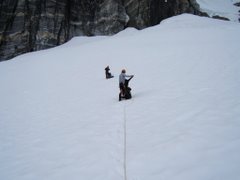
Yesterday, my advisor-Berry Lyons, and I sampled the east side of the Canada Glacier--- a waterfall from the glacier, and the Canada Stream (the stream along the glacier margin). We caught a helicopter from Lake Hoare and flew over the glacier landing a safe distance from the stream

We had a special permit to sample this area, as it is restricted--- unusual mosses line the stream -----many species in a suite of colors. This makes the area very unique ecologically. We had to walk as nimbly as possible, and jump from rock to rock to avoid mosses and algal matts. I am excited to see if the mosses are taking up metals as the stream moves off the glacier. (And also if the geochemistry of the glacier surface reflects wind blown mosses and matts). It was a pleasure to sample with Berry, given his experience in the Valleys and his insights. We navigated the stream margin to find a safe place to sample and not injure the matts. The soil near the stream is saturated, a hyphoreic zone, where the ice surrounding the stream has thawed in the summer warmth. If you aren't careful, you can sink coating your boots in ooze.

Over the radio we listened to Diane McKnight and Karen Cosseto's field parties sample a nearby river in a neatly orchestrated tracer experiment--- with many people involved and sampling every 15 minutes for 24 hours. We had a much more relaxed experience--- although, hopefully, all of our parties end up with excellent data.
After sampling, we caught a 40 minute helicopter flight back into McMurdo.

The pilot, Scotty, joked asking if I had a good round of golf while I was in the valleys. My husband's golf bag was neatly packed with equipment. Golf aside, we flew into McMurdo in the shadow of Mount Erebus, the largest active volcanoe in Antarctica. The clouds covered the cauldera making it seem much more subdued than it usually seems, a slim puff of smoke hangs in clear horizons. Now I'm packing samples and equipment up. The cargo vessel has not arrived yet, but is due any day. I will ship out over 70 lbs--- which won't make it to Columbus, Ohio until May. I will have time to write a few fellowship applications and get out to Mount Hood again in March for some sampling on the Eliot Glacier. For now, I am going to head to Scott Base and walk up Observation Hill. Enjoying the calm weather we have in McMurdo.
 There was an Antarctic driving contest recently... (see the greens- or rather blues of the Ross Sea Ice above) my golf bag would have come in handy after all. Too bad it is already on the ship.
There was an Antarctic driving contest recently... (see the greens- or rather blues of the Ross Sea Ice above) my golf bag would have come in handy after all. Too bad it is already on the ship.  In the meantime, I've lugged all of my gear up the hill into the loading area for the plane tomorrow. I have one small bag to live on until our flight tomorrow... unless the flight is delayed in which case, people have been known to live on one small bag of personal effects for weeks. (Its more of a big purse...)Which is fine in the field... but strange in McMurdo Station, where I'm always in awe of the amount and variety of clothes people have here....from ball gowns to cowboy hats.
In the meantime, I've lugged all of my gear up the hill into the loading area for the plane tomorrow. I have one small bag to live on until our flight tomorrow... unless the flight is delayed in which case, people have been known to live on one small bag of personal effects for weeks. (Its more of a big purse...)Which is fine in the field... but strange in McMurdo Station, where I'm always in awe of the amount and variety of clothes people have here....from ball gowns to cowboy hats.






